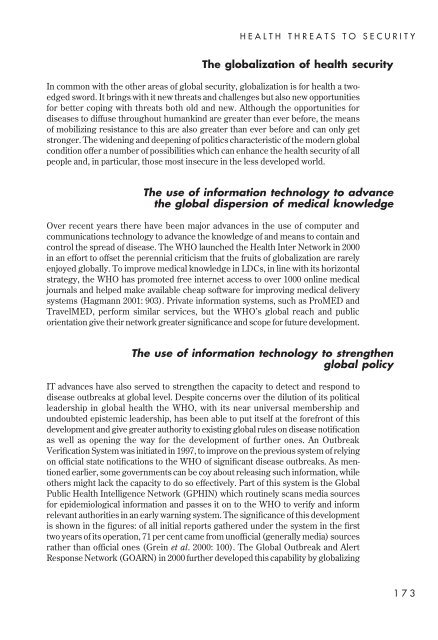Understanding global security - Peter Hough
Understanding global security - Peter Hough
Understanding global security - Peter Hough
Create successful ePaper yourself
Turn your PDF publications into a flip-book with our unique Google optimized e-Paper software.
HEALTH THREATS TO SECURITY<br />
The <strong>global</strong>ization of health <strong>security</strong><br />
In common with the other areas of <strong>global</strong> <strong>security</strong>, <strong>global</strong>ization is for health a twoedged<br />
sword. It brings with it new threats and challenges but also new opportunities<br />
for better coping with threats both old and new. Although the opportunities for<br />
diseases to diffuse throughout humankind are greater than ever before, the means<br />
of mobilizing resistance to this are also greater than ever before and can only get<br />
stronger. The widening and deepening of politics characteristic of the modern <strong>global</strong><br />
condition offer a number of possibilities which can enhance the health <strong>security</strong> of all<br />
people and, in particular, those most insecure in the less developed world.<br />
The use of information technology to advance<br />
the <strong>global</strong> dispersion of medical knowledge<br />
Over recent years there have been major advances in the use of computer and<br />
communications technology to advance the knowledge of and means to contain and<br />
control the spread of disease. The WHO launched the Health Inter Network in 2000<br />
in an effort to offset the perennial criticism that the fruits of <strong>global</strong>ization are rarely<br />
enjoyed <strong>global</strong>ly. To improve medical knowledge in LDCs, in line with its horizontal<br />
strategy, the WHO has promoted free internet access to over 1000 online medical<br />
journals and helped make available cheap software for improving medical delivery<br />
systems (Hagmann 2001: 903). Private information systems, such as ProMED and<br />
TravelMED, perform similar services, but the WHO’s <strong>global</strong> reach and public<br />
orientation give their network greater significance and scope for future development.<br />
The use of information technology to strengthen<br />
<strong>global</strong> policy<br />
IT advances have also served to strengthen the capacity to detect and respond to<br />
disease outbreaks at <strong>global</strong> level. Despite concerns over the dilution of its political<br />
leadership in <strong>global</strong> health the WHO, with its near universal membership and<br />
undoubted epistemic leadership, has been able to put itself at the forefront of this<br />
development and give greater authority to existing <strong>global</strong> rules on disease notification<br />
as well as opening the way for the development of further ones. An Outbreak<br />
Verification System was initiated in 1997, to improve on the previous system of relying<br />
on official state notifications to the WHO of significant disease outbreaks. As mentioned<br />
earlier, some governments can be coy about releasing such information, while<br />
others might lack the capacity to do so effectively. Part of this system is the Global<br />
Public Health Intelligence Network (GPHIN) which routinely scans media sources<br />
for epidemiological information and passes it on to the WHO to verify and inform<br />
relevant authorities in an early warning system. The significance of this development<br />
is shown in the figures: of all initial reports gathered under the system in the first<br />
two years of its operation, 71 per cent came from unofficial (generally media) sources<br />
rather than official ones (Grein et al. 2000: 100). The Global Outbreak and Alert<br />
Response Network (GOARN) in 2000 further developed this capability by <strong>global</strong>izing<br />
173
















